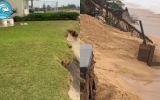
Residents of a low-lying area on the NSW central coast have been urged to evacuate as the wild storm hitting the area causes dangerous erosion.
The NSW State Emergency Service issued the evacuation notice for houses along Hutton Road at North Entrance shortly before 4pm on Tuesday (AEST).
“You must evacuate now because it may become too dangerous to stay in this area,” it warned.
They are among millions of residents from Coffs Harbour to Bega, some 800 kilometres south, in the path of the fast-moving, severe low-pressure system that is intensifying off the NSW north coast, which will also bring damaging winds of up to 110km/h.
The rapidly deepening system is known as a “bomb cyclone”, though the meteorological term is generally used sparingly so as not to incite panic, the Bureau of Meteorology says.
NSW Emergency Services Minister Jihad Dib said earlier the east coast wasn’t out of the woods and the weather would likely get worse later on Tuesday and into Wednesday.
“The sheer size of [the storm] is quite enormous,” Dib said.
“This situation is going to worsen over the course of the next 24 hours, particularly over this afternoon, into the evening and early tomorrow.
“This is not the time for complacency. In the next 24 hours, there’s a chance of more rain and strong and damaging winds.”
Forecaster Weatherzone said there had already been widespread 24-hour rainfall accumulations of 20-40 millimetres between Noosa, in south-east Queensland and Ulladulla on the NSW south coast. There were also heavier falls of 70-120 millimetres at near Jervis Bay and north of Newcastle.
“The proximity to the coast means that intense rain, damaging winds and hazardous surf are all being generated and sent into nearby areas to the south and west of the low. This includes most areas between Newcastle and Moruya, including Sydney and Wollongong,” it said.
Up to 120 millimetres of rain is expected to lash greater Sydney alone by Tuesday night.
NSW SES Deputy Commissioner Debbie Platz urged everyone in the storm zone to prepare.
“We are encouraging people to please make sure that you are tying down any loose items, please make sure your gutters are clean, make your your vehicles are not underneath trees, please have a medical and emergency kit ready, and please have a plan and a communication plan for your family, friends and neighbours, so that you know who to contact should you have to evacuate in an emergency,” she said.
“This system is a very dynamic system. It is fast-moving and very different to recent events that we have seen in NSW. What we expect is that rain will be very rapid, it will be heavy, it will be short and sharp. Because of that, we do need everybody to really stay prepared.”
The weather has caused major disruptions at Sydney Airport, with 21 departure flights and 19 arrivals cancelled early on Tuesday.
“It’s havoc here, we can’t get our luggage through so we’ve literally got to sit here,” one stranded passenger told the ABC.
The weather bureau has issued flood watch warnings for southern parts of the mid-north coast, Hunter, Hawkesbury-Nepean, Sydney Illawarra Coast and Snowy catchments.
But flash flooding was the bigger risk due to the fast-moving nature of the weather compared, compared with the slow, pounding rain that inundated the mid-north coast earlier this year, the SES said.
“While we are concerned about riverine flooding, the most impact from this significant rainfall will be flash flooding, and this is likely to occur anywhere from Newcastle, Sydney and in the Illawarra region,” Platz said.
The SES had more than 900 calls since 5am on Monday, and responded to more than 600 incidents.
Most were from people preparing properties for an inundation, but many were relating to damage caused by fallen trees.
The peak impact of the system is forecast to for Wednesday, and there’s a risk of flash flooding at Wallis Lake, near Taree on the mid-north coast.
Taree was one of the towns hard hit by floods in May that killed five people and damaged thousands of properties.
The NSW mid-north coast is an area of concern for emergency services because the soil is still saturated from the May floods.
Rain rates and winds are expected to ease on Wednesday and ocean swells should ease on Thursday.
-with AAP










